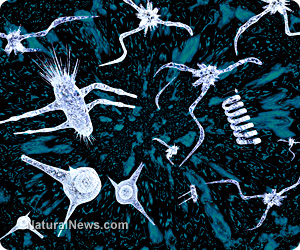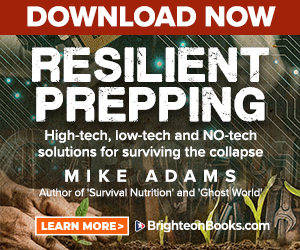
Antibacterial soap pollutes rivers, adds to bacterial resistance
Wednesday, October 02, 2013 by: L.J. Devon, Staff Writer
Tags: antibacterial soap, bacterial resistance, river pollution
- Russia escalates censorship war, targets over 200 VPN apps amid Google resistance
- Mel Gibson sparks outcry over 9/11 ‘Biggest Scandal’ remark as unanswered questions resurface
- BIRD FLU ZOMBIE APOCALYPSE: Injected humans to become SPIKE PRION FACTORIES due to “replicon” technology in the upcoming mRNA "vaccines"
- Surge in KIDNEY FAILURES linked to common medications
- DMSO: Nature's healing solvent with revolutionary potential - from cancer treatment to regenerative medicine
- Massachusetts pediatrician conscripts law enforcement, unleashes nationwide manhunt for Fitchburg family-of-five who declined vaccinations for their healthy kids
- North Dakota town exposes Big Fluoride and Big Government corruption in federal water poisoning scheme
- Aerosolized bioweapons? Strange “diploid biomasses” falling out of the sky in Florida captured under the microscope
- Big Tech accused of $278 billion tax underpayment over the past decade
- Major baby food brands exceed California lead limits, risking children’s health
- Germany's gold dilemma: Urgent calls to audit U.S.-held reserves amid political tensions
- Fauci is back in the limelight, and he’s busy promoting a future COVID or FLU pandemic
- Widespread social and economic unrest: Steve Quayle issues urgent financial warning of imminent asset collapse in new interview with Mike Adams
- Daniel Estulin’s “Tavistock Institute: Social Engineering the Masses” reveals the organization’s hidden hand in social engineering
- How North Korea’s massive military aid is keeping Putin’s war machine running
- Trump’s surprise role in Japan trade talks signals new economic order
- Kiss Your Genetic Privacy Good-Bye! 23andMe Gets Green Light to Sell Your Intimate Genetic Details to Anyone They Want
- A struggle over energy future unfolds as developers defy executive order
- Aerosolized bioweapons? Strange “diploid biomasses” falling out of the sky in Florida captured under the microscope
- Analysis: The coming economic collapse, a mass uprising and Trump's three secret weapons to halt the growing revolt
- Israeli lobbyists boast of controlling US national security policy in leaked AIPAC audio
- Widespread social and economic unrest: Steve Quayle issues urgent financial warning of imminent asset collapse in new interview with Mike Adams
- Fauci is back in the limelight, and he’s busy promoting a future COVID or FLU pandemic
- Kiss Your Genetic Privacy Good-Bye! 23andMe Gets Green Light to Sell Your Intimate Genetic Details to Anyone They Want
- TAKE IT DOWN Act advances in Congress amid free speech concerns
- U.S. lawmakers investigate Meta over alleged China collaboration
- Mike Adams releases country western hit single: Goin’ Back in Time is Comin’ Home
- CLOT SHOT PLANDEMIC UNFOLDING: Fibrous, rubbery clots caused by covid injections have prion-like seeding activity
- Dane Wigington exposes climate engineering as ‘All-Out Weather and Biological Warfare’
- Tulsi Gabbard leads charge against the Biden regime’s global censorship of the 'Disinformation Dozen'
- Pfizer's RSV vaccine linked to preterm births as drug giant CONCEALED RISKS from pregnant women in unethical clinical trials
- Criminal referral requests filed against Fauci and top COVID officials in seven states
- Defunding DEADLY mRNA jabs: Government funding for mRNA technology being scrutinized and sidelined until proven "safe and effective" for real
- Curcumin’s ancient healing power supercharges muscle recovery, and its effects are compounded with anti-inflammatory foods and supplements
- Shedding light on the dark side of MMR vaccines: How vaccinated individuals SPREAD MEASLES & put the vulnerable at risk
- Government waste exposed: Hegseth supports Musk’s demand for accountability from federal workers
- Newly released JFK files reveal Pentagon's role in creating Lyme disease and covid in the same lab
- Analysis: The coming economic collapse, a mass uprising and Trump's three secret weapons to halt the growing revolt
- Aerosolized bioweapons? Strange “diploid biomasses” falling out of the sky in Florida captured under the microscope
- Mike Adams releases country western hit single: Goin’ Back in Time is Comin’ Home
- Kiss Your Genetic Privacy Good-Bye! 23andMe Gets Green Light to Sell Your Intimate Genetic Details to Anyone They Want
- European Court of Justice: Healthcare professionals who promoted or administered COVID-19 vaccines are CRIMINALLY LIABLE for any harm caused
- Widespread social and economic unrest: Steve Quayle issues urgent financial warning of imminent asset collapse in new interview with Mike Adams
- Federal employees whine over DOGE's new directive requiring them to do a 5-point summary of weekly accomplishments
- U.S. approves new Russian ambassador as diplomatic thaw continues
- Government waste exposed: Hegseth supports Musk’s demand for accountability from federal workers
- Fauci is back in the limelight, and he’s busy promoting a future COVID or FLU pandemic
- Now you can HEAR chemistry: Health Ranger translates molecules into music in stunning video demonstration that will blow your mind (and your ears)
- CLOT SHOT PLANDEMIC UNFOLDING: Fibrous, rubbery clots caused by covid injections have prion-like seeding activity
- I Want My Bailout Money – new song and music video released by Mike Adams
- I Want My Bailout Money – new song released by Mike Adams
- Trump administration poised to overhaul crypto regulations with new SEC leadership
- Defunding DEADLY mRNA jabs: Government funding for mRNA technology being scrutinized and sidelined until proven "safe and effective" for real
- South Carolina Congressman proposes new $250 bill and wants Trump on the front
- Red Cross issues warning to stop blood plasma donations from vaccinated people
- Scientists confirm: GENIUS brain function can be spontaneously unleashed in humans without any apparent cause
- EPA advisor admits the agency is funneling billions to climate groups ahead of Trump’s return to White House
- HYSSOP: What research reveals about the health benefits of this ancient holy herb
- Two containers with completed ballots fall out of truck in Florida
- Newly released JFK files reveal Pentagon's role in creating Lyme disease and covid in the same lab
- Mike Adams releases country western hit single: Goin’ Back in Time is Comin’ Home
- Global leaders unite to clamp down on “misinformation” with UN-backed Cascais Declaration
- BREAKING: 2025 NDAA authorizes mandatory military draft of WOMEN across America… as Pentagon pursues global NUCLEAR war with both Russia and China at the same time
- Michael Yon warns of a ZIONIST TAKEOVER in Trump’s second administration
- I Want My Bailout Money – new song released by Mike Adams
- The Health Ranger releases “Vaccine Zombie” song and music video, using AI-animated zombies for the music video
- Ozempic and Wegovy weight loss drugs are injectable LIZARD VENOM PEPTIDES that may unleash a devastating wave of organ failure… side effects align with symptoms of SNAKE BITES
- BOMBSHELL: DNA testing kits are a SCAM to develop ethnic-specific bioweapons
- Israeli soldiers accused of even more torture and abuse in the West Bank
- These 13 countries just signed an agreement to engineer a global FAMINE by destroying food supply
- NASA admits that climate change occurs because of changes in Earth’s solar orbit, and NOT because of SUVs and fossil fuels
- RFK Jr. clears key hurdle: Sen. Susan Collins backs controversial HHS nominee, signaling a new era for health policy
New environmental studies from the Chicago metro-area are now reporting disturbing levels of powerful bacteria strains coming from specific urban areas that rely on single sewage pipes connected to combined sewer overflows.
A paper published in the journal Environmental Science and Technology, unveils the causes behind the new strains of bacteria.
The culprit: triclosan resistance in a natural environment.
What is triclosan?
Triclosan is a synthetic antibacterial chemical often added to personal body care products. It is pervasive in commercial toothpastes, mouthwashes, soaps and deodorants. Products like Dial liquid soap, Clearasil Daily Face Wash, Colgate Total Toothpaste, Old Spice Deodorant and even Jason natural products contain the synthetic triclosan.It is constantly being flushed down the sewage system. Water treatment facilities can effectively remove triclosan, but in some cities, leaky sewer infrastructure and sewer overflows send the chemical out into the environment, where it is gobbled up by nearby rivers, streams and groundwater.
The chemical was initially invented as an antibacterial agent for surgeons in the 1960s. Now it's currently being used in over half of today's commercials body care products. Mass produced in liquid soaps, toothpastes and other cosmetics, triclosan has multiple synthetic uses, but
if the body care industry was honest, then triclosan could become extinct.
Honest body care manufacturers could start using natural antibacterial ingredients like grapefruit seed extract. The environment that people depend on would appreciate grapefruit seed runoff much more than mass dumps of chemical triclosan.
Aquatic ecologist Rosi-Marshall says, "The bacterial resistance caused by triclosan has real environmental consequences. Not only does it disrupt aquatic life by changing native bacterial communities, but it's linked to the rise of resistant bacteria that could diminish the usefulness of important antibiotics."
Triclosan levels highest in urban areas where sewage overflows
Joined by colleagues from Loyola University and the Illinois Sustainable Technology Center, Rosi-Marshall tested three of Chicago's urban water sources and how the bacteria living there responds to triclosan in both its natural state and in controlled settings. The three sites tested included the urban North Shore Channel of the Chicago metropolitan region, the suburban West Branch on the Dupage River and the rural Nippersink Creek outside Chicago.What they found out was that urbanization is directly correlated with higher triclosan levels. Higher triclosan concentrations were found in the portion of sediments containing bottom-dwelling bacteria strains that are highly resistant to triclosan.
Urban areas often rely on sewage systems that can back up during high rain fall. Chemicals like triclosan are high in urban sewage and industrial waste water, so when the single pipes back up during a storm, these chemicals overflow into the surrounding environment. The result: new strains of bacteria evolve in resistance to the heightening triclosan levels.
For instance, the researchers found the highest levels of triclosan-resistant bacteria residing in the urban North Shore channel, which is connected to 25 combined sewer overflows.
Furthermore, a woodland creek outside the city showed the lowest levels of triclosan-resistant bacteria.
John Kelly of Chicago's Loyola University, the paper's senior author, says, "We detected much lower levels of triclosan at a site downstream of a sewage treatment facility as compared to a site downstream of combined sewer overflows. And we demonstrated a strong link between the presence of triclosan in the environment and the development of triclosan resistant bacteria."
Composition of entire bacterial communities "shifting"
To make matters worse, the researchers are noticing new trends in bacteria evolution. They found a decrease in the diversity of benthic bacteria and an overall shift in the composition of bacterial communities. Cyanobacteria have increased six fold in triclosan-laced water, while entire communities of algae are experiencing massive die-offs. These shifts can impact aquatic life.Rosi Marshall explains, "Cyanobacteria are less nutritious than algae and can produce toxins. In triclosan-polluted streams and rivers, changes in microbial communities could negatively affect ecological function and animal communities."
Urban areas in Chicago are not the only concern. The EPA lists at least 800 cities that rely on single pipes connected to combined sewer overflows that are ultimately responsible for regional water pollution, rising strains of resistant bacteria and shifts in entire bacteria communities.
Sources for this article include:
http://www.eurekalert.org
http://science.naturalnews.com
http://www.upci.upmc.edu
http://newyorkorthodontists.net
http://drbenkim.com
Antibacterial soap at FETCH.news
Get independent news alerts on natural cures, food lab tests, cannabis medicine, science, robotics, drones, privacy and more.
Take Action: Support Natural News by linking to this article from your website
Permalink to this article:
Embed article link: (copy HTML code below):
Reprinting this article:
Non-commercial use OK, cite NaturalNews.com with clickable link.
Follow Natural News on Facebook, Twitter, Google Plus, and Pinterest
Science News & Studies
Medicine News and Information
Food News & Studies
Health News & Studies
Herbs News & Information
Pollution News & Studies
Cancer News & Studies
Climate News & Studies
Survival News & Information
Gear News & Information
News covering technology, stocks, hackers, and more



"Big Tech and mainstream media are constantly trying to silence the independent voices that dare to bring you the truth about toxic food ingredients, dangerous medications and the failed, fraudulent science of the profit-driven medical establishment.
Email is one of the best ways to make sure you stay informed, without the censorship of the tech giants (Google, Apple, Facebook, Twitter, YouTube, etc.). Stay informed and you'll even likely learn information that may help save your own life."
–The Health Ranger, Mike Adams













































